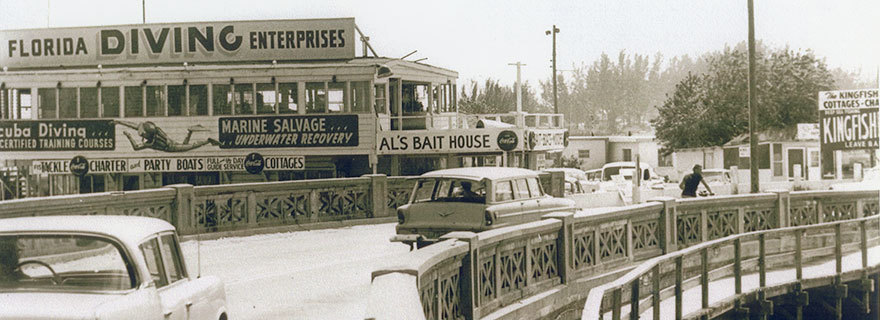[printfriendly]The connection between our natural environment and the tourist pipeline
By James Anthony Schnur
Florida’s lengthy coastline and abundant estuaries have shaped the “visitor experience” since the earliest days of commercial tourism in our state. Generations of Florida’s tourists have enjoyed water activities from today’s Winter the dolphin at the Clearwater Marine Aquarium or Snooty the manatee at the South Florida Museum to yesteryear’s glass-bottom boat trips through Silver Springs.
Nearly a decade before Henry Plant’s railroads reached the Tampa Bay region or Henry Flagler’s Florida East Coast Railways became a backbone along the peninsula, the 1875 Guide to Florida (available online) introduced readers to a remote, exotic, subtropical and sparsely populated state best reached by steamboat.
The earliest substantial tourist destinations in the Tampa Bay region, introduced after the arrival of the railroads, also sat close to the water. Henry Plant’s elegant Tampa Bay Hotel, which now comprises the main structures of the University of Tampa campus, opened in 1891. Perched along the western side of Hillsborough River near its mouth at Tampa Bay, it soared in elegant contrast above the warehouses, wooden shacks and other industrial structures on the other side of the river in “Tampa Town.” After acquiring the former Orange Belt Railway that brought rail service to the Pinellas peninsula in 1887-1888, Plant supervised the construction of Belleview Hotel (later the Belleview-Biltmore Resort and Spa), a wooden masterpiece that opened in 1897 along a bluff south of Clearwater.
These early accommodations operated during a winter season when Florida’s mild temperatures attracted wealthy snowbirds. Before the early land booms that came to the area in the 1910s and 1920s, however, many year-round residents tended to live away from low-lying coastal settlements. They only came to the shoreline to engage in practical or commercial activities, such as harvesting fish and seafood, gathering shallow sponges, or awaiting commodities that arrived by boat from Cedar Key or Key West.
Water-based tourist destinations expanded in the early 1900s, and this trend accelerated during the land boom of the 1920s. Plant’s shipping enterprises took tourists on excursions from Port Tampa, along the Interbay peninsula to destinations throughout the area. Steamboats such as the Mary Disston plied the Anclote River in the 1890s, and the springs at Green Springs, later named Safety Harbor, attracted growing interest during the early 1900s.
In his study of Florida’s roadside attractions, Ken Breslauer asserted that the “golden age” of natural, Florida-themed tourist destinations spanned the period from 1929 through 1971. President Calvin Coolidge dedicated Bok Tower Gardens in Lake Wales in February 1929; Walt Disney World opened in October 1971, forever redefining the tourist experience in Florida.
During that golden age, water-based tourist destinations benefitted from strong mosquito eradication campaigns. In Pinellas County, for example, the Anti-Mosquito Association began its efforts to persuade county officials to set aside funds for a mosquito control district. Some of these attractions, such as Pier 60 along Clearwater Beach and Weeki Wachee Springs, attracted tourists for generations. Other venues made their mark before shifting sands and priorities led to their demise. Some of the most interesting include:
- Joyland Pavilion in Clearwater Beach was a popular gathering place that included “Silver Dome Hall” with its waterslide into a pool in the late 1920s and early 1930s. Known as the “Coolest Dance Pavilion in Florida,” Joyland became a popular destination for the “Tin Can Tourists” who camped in or alongside their jalopies.
- During the same period, Madeira Casino offered a fishing pond, pony rides and even circus performances along an otherwise-empty beach.
- Near the former Million Dollar Pier in St. Petersburg was a municipal Solarium that somewhat resembled an Egyptian temple. It included separate bathing areas where up to 500 men and women could sunbathe in the nude.
- The Marine Arena, which opened in Madeira Beach in 1953 as the “West Coast’s Largest Aquarium,” attracted tourists with shows like “Paddy the Porpoise” and other exhibits. The attraction closed in 1965 after the much larger Aquatarium opened in St. Pete Beach. By the mid-1970s, facing new competition from Disney World and Busch Gardens, owners of the Aquatarium tried to capitalize on the popularity of the Jaws movies by renaming the venue Shark World. Escalating land values led to the site’s closure in September 1978, and by the 1980s condos occupied the land.
- A dredge-and-fill operation allowed the opening of Tiki Gardens in the spring of 1964. For nearly 30 years, the Polynesian-themed tourist destination near The Narrows along Indian Shores was one of the most popular attractions in the region.
The bond between Florida’s natural systems and its economic success has been an important asset for over a century, and continues through today. A recent study by the Tampa Bay Regional Planning Council, with funding from the Tampa Bay Estuary Program, reconfirmed that connection, showing that nearly 20% of the jobs in the region are dependent upon a clean and healthy bay.
[su_divider]